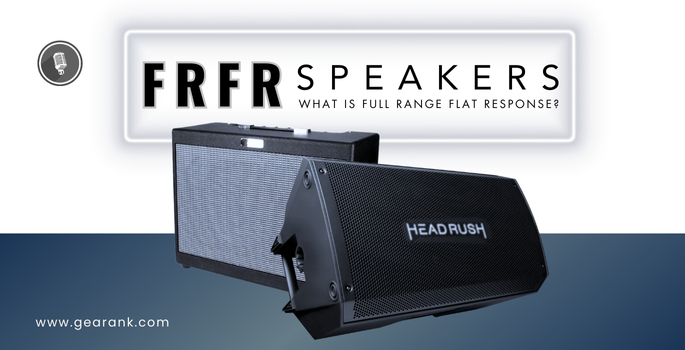Ever found yourself amidst a gaggle of musicians, only to be met with the cryptic utterance of “FRFR”? Does it sound like some arcane incantation or perhaps a secret society handshake? Fear not, for deciphering this acronym is far simpler than summoning eldritch entities or infiltrating clandestine gatherings. It stands for “Full Range, Flat Response.” But what does that *actually* mean in the sonorous world of speakers and amplification, and why should any discerning audiophile, let alone a budding guitarist, care?
FRFR, at its core, represents a speaker system’s ambition – or perhaps, its solemn vow – to reproduce audio with pristine fidelity. It seeks to deliver sound without imposing its own sonic “flavor” or coloration. This means that across the audible frequency spectrum (roughly 20 Hz to 20 kHz), the speaker should amplify each frequency equally. Ideally, a pure sine wave fed into an FRFR system should emerge as a pure sine wave, only louder. No peaks. No dips. Just pure, unadulterated sonic truth. This is a significant departure from traditional guitar amplifiers, which are deliberately designed to shape and sculpt the sound, contributing significantly to a guitarist’s signature tone.
Consider, for example, the iconic midrange “hump” of a classic tube amp. This coloration, a deliberate frequency boost in the mid frequencies, is a crucial element of its sonic character. FRFR systems eschew such manipulations. They aim to be sonically transparent. This transparency allows for the authentic reproduction of digitally modeled amplifier tones or complex multi-effects setups. Without FRFR, the nuances of these digital recreations can be lost, overwhelmed by the inherent coloration of a non-FRFR speaker. Put simply, the meticulously crafted sonic landscapes created within your digital modeler would be filtered through a pre-existing tonal lens, diminishing their intended effect.
The primary application of FRFR technology lies in the realm of amp modelers and digital effects processors. These devices meticulously emulate the sound and behavior of various amplifiers, cabinets, and effects pedals. To faithfully reproduce these emulations, the speaker system must not impart its own sonic fingerprint. Think of it as a painter using a perfectly neutral canvas to showcase the vibrancy and detail of their art. Any coloration in the canvas itself would inevitably alter the perception of the artwork. FRFR speakers act as that neutral canvas for digital audio, allowing the true character of the modeled tones to shine through.
But the quest for sonic neutrality isn’t without its challenges. Achieving a truly “flat” frequency response is a complex engineering feat. Speaker components, cabinet design, and even the acoustic environment in which the speaker is placed can all introduce unwanted coloration. Manufacturers employ sophisticated techniques like digital signal processing (DSP) and precise component selection to minimize these distortions. Even with these advancements, true FRFR is an aspiration rather than an absolute. There will always be subtle variations in frequency response. However, the goal is to keep these variations within acceptable tolerances, ensuring that the speaker’s influence on the overall sound is minimal.
One common misconception is that FRFR speakers are inherently “better” than traditional guitar amplifiers. This is patently false. They simply serve a different purpose. Traditional amplifiers are designed to be part of the instrument, contributing to the overall tonal palette. FRFR systems, on the other hand, are designed to be invisible, revealing the inherent sonic characteristics of the source material. The “best” choice depends entirely on the application and desired outcome. If you’re seeking the raw, unadulterated sound of a specific amplifier model, then an FRFR system paired with a quality amp modeler is the ideal solution. If you prefer the organic feel and responsiveness of a traditional tube amp, then FRFR may not be the best fit.
Furthermore, the benefits of FRFR extend beyond the realm of guitar amplification. These systems excel in any application where accurate and uncolored sound reproduction is paramount. This includes studio monitoring, live sound reinforcement, and even high-fidelity home audio. An FRFR monitor can provide a more accurate representation of your mix, allowing for more informed mixing decisions. In live sound, FRFR systems can ensure that instruments and vocals are reproduced with clarity and fidelity, preserving the nuances of the performance. In home audio, an FRFR system can deliver a listening experience that is true to the original recording, free from unwanted coloration or distortion.
Choosing the right FRFR system requires careful consideration. Key factors to consider include frequency response, power handling, speaker size, and cabinet design. A wider frequency response generally indicates a more accurate and detailed sound reproduction. Power handling determines the maximum volume level that the speaker can produce without distortion. Speaker size can affect the low-end response, with larger speakers generally producing more bass. Cabinet design plays a crucial role in shaping the overall sound, with different designs offering different sonic characteristics. It is advisable to test several FRFR systems with your preferred amp modeler or digital effects processor to determine which one best suits your sonic preferences.
In conclusion, FRFR represents a commitment to sonic transparency – a quest to reproduce audio with utmost accuracy. While achieving a perfectly “flat” response remains an elusive ideal, FRFR systems offer a powerful tool for musicians, engineers, and audiophiles who demand the highest levels of fidelity. By understanding the principles behind FRFR and carefully considering your specific needs, you can unlock a world of sonic possibilities and experience your music in a whole new light. So, the next time you hear the term “FRFR,” you’ll not only know what it means, but also understand its significance in the ever-evolving landscape of audio technology.









Leave a Comment